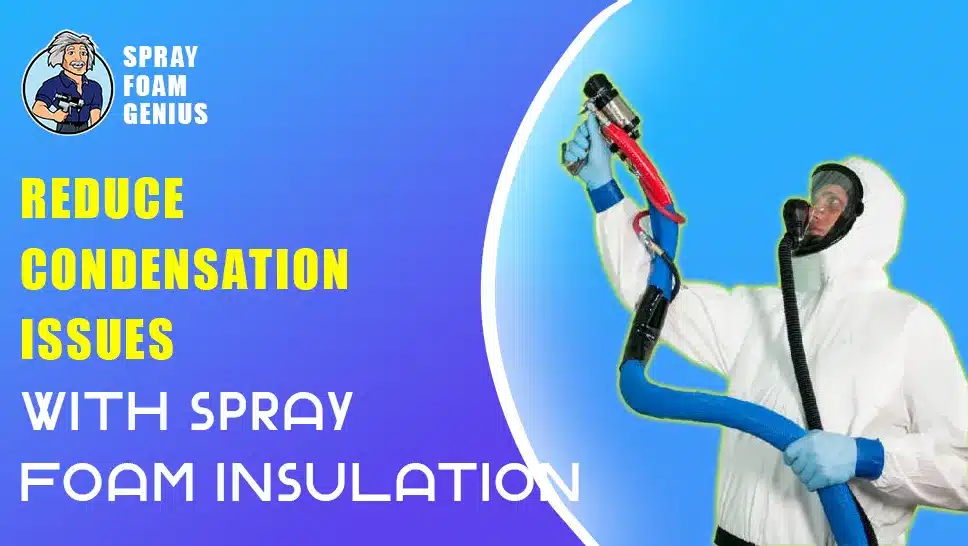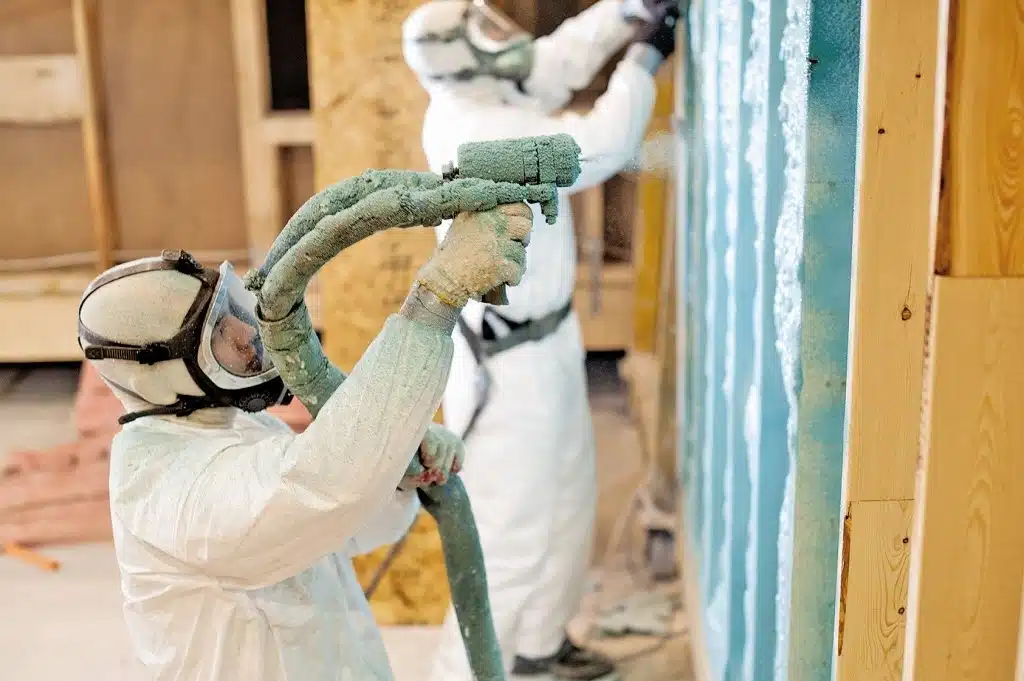
Condensation is a common issue in many buildings, leading to a variety of problems including mold growth, structural damage, and diminished indoor air quality. Spray foam insulation has proven to be an effective solution for tackling these problems. This guide explores how spray foam insulation can help reduce condensation issues, its numerous benefits, and best practices for implementation. Whether you’re a homeowner or a property manager, understanding these aspects will help you make informed decisions about improving your building’s insulation.
What is Condensation?
Understanding Condensation
Condensation occurs when warm, moist air comes into contact with a cooler surface, resulting in the conversion of water vapor into liquid droplets. Several factors contribute to this phenomenon:
- Temperature Differences: Condensation often forms when the temperature of indoor surfaces falls below the dew point of the air inside. This typically happens in poorly insulated areas, causing surfaces such as windows, walls, or pipes to cool excessively.
- Humidity Levels: High indoor humidity levels increase the likelihood of condensation. Activities such as cooking, showering, or even breathing add moisture to the air, which can condense on cooler surfaces if not properly managed.
- Ventilation: Insufficient ventilation can trap moisture indoors, exacerbating condensation problems. Proper ventilation is essential for maintaining balanced indoor moisture levels and ensuring good air quality.
Impact of Condensation
Condensation can lead to several significant issues within a building:
- Mold and Mildew Growth: Excess moisture creates an ideal environment for mold and mildew to thrive. This can cause health problems, including respiratory issues and allergies. Mold also damages building materials, leading to costly repairs.
- Structural Damage: Continuous moisture from condensation can lead to wood rot, peeling paint, and deterioration of structural components. Over time, this can compromise the building’s structural integrity.
- Decreased Indoor Air Quality: Mold spores and other contaminants from condensation can lower indoor air quality, affecting comfort and health. This may result in long-term respiratory problems and a decrease in overall well-being.
How Spray Foam Insulation Works
What is Spray Foam Insulation?
Spray foam insulation involves applying a liquid foam mixture that expands and hardens to form a seamless, airtight barrier. It comes in two primary types:
- Open-Cell Foam: This type is softer and more flexible, offering good thermal insulation and soundproofing. Open-cell foam is well-suited for areas with moderate moisture levels, providing effective control of indoor temperatures.
- Closed-Cell Foam: Denser and more rigid, closed-cell foam provides superior insulation and moisture resistance. It is ideal for high-humidity areas or locations prone to water exposure, such as basements and crawl spaces.
How Spray Foam Expands
When applied, spray foam starts as a liquid that expands upon contact with the surface. This expansion fills all gaps and cracks, creating a continuous barrier that prevents air leaks and moisture infiltration. This feature is crucial for controlling condensation within the building.
Benefits of Spray Foam Insulation for Condensation Control
1. Improved Air Sealing
One of the primary advantages of spray foam insulation is its ability to create an airtight seal. Unlike traditional insulation materials, spray foam expands to fill every gap and seam, significantly reducing air leakage. This airtight seal helps to maintain a consistent indoor temperature and minimizes the risk of condensation.
- Reduced Drafts: By effectively sealing gaps and cracks, spray foam insulation minimizes drafts, creating a more comfortable indoor environment.
- Enhanced Temperature Regulation: The insulation helps to maintain stable indoor temperatures, which reduces the temperature differential that can lead to condensation.
2. Enhanced Moisture Resistance
Closed-cell spray foam insulation excels at resisting moisture. Its dense structure acts as a barrier to water vapor, preventing moisture from penetrating the insulation layer.
- Water Barrier: Closed-cell foam provides a robust barrier against water vapor, significantly reducing the risk of condensation.
- Ideal for High-Humidity Areas: This type of foam is particularly effective in areas prone to high humidity, such as basements, crawl spaces, and unventilated attics. It prevents moisture from entering these spaces, which is crucial for preventing mold growth and structural damage.
3. Regulated Indoor Temperature
Spray foam insulation significantly enhances thermal insulation, helping to maintain stable indoor temperatures. Consistent temperatures reduce the likelihood of condensation forming on cooler surfaces.
- Consistent Comfort: By stabilizing indoor temperatures, spray foam insulation ensures a more comfortable living environment throughout the year. This consistency is especially valuable during extreme weather conditions, ensuring that your indoor space remains pleasant.
- Energy Efficiency: Improved insulation reduces the workload on heating and cooling systems, leading to lower energy bills. Spray foam insulation not only enhances comfort but also contributes to overall energy savings.
4. Increased Energy Efficiency
Beyond its role in controlling condensation, spray foam insulation boosts overall energy efficiency by creating a more effective thermal barrier. This leads to:
- Lower Energy Bills: With reduced energy loss, your heating and cooling systems operate more efficiently, resulting in lower energy costs. Spray foam insulation helps to maintain the desired temperature with less energy, reducing utility expenses.
- Environmental Benefits: Enhanced energy efficiency also lowers your carbon footprint by reducing energy consumption. This makes your home more environmentally friendly and contributes to sustainability efforts.
Implementing Spray Foam Insulation

1. Professional Installation
To fully benefit from spray foam insulation, professional installation is essential. Experienced contractors ensure that the insulation is applied correctly and effectively.
- Choosing a Contractor: Select contractors with expertise in spray foam insulation who can assess your specific needs and apply the insulation according to industry standards. An experienced professional will ensure that the installation process is seamless and efficient.
- Building Code Compliance: Ensure that the installation meets local building codes and regulations. Compliance with these codes guarantees safety and effectiveness, preventing potential issues down the line.
2. Assessing Building Needs
Before installation, evaluate your building’s specific requirements to determine the best type of spray foam and application areas.
- Moisture Levels: Assess existing moisture levels and potential sources of water exposure. This evaluation helps in choosing between open-cell and closed-cell foam based on the moisture conditions in your building.
- Insulation Requirements: Identify areas that require insulation and select the type of foam that best addresses your needs. Consider factors such as climate, building structure, and existing insulation to make an informed decision.
3. Post-Installation Maintenance
Regular maintenance is crucial to ensure the long-term effectiveness of spray foam insulation.
- Periodic Inspections: Conduct regular inspections to detect any issues, such as damage or settling, that might affect the insulation’s performance. Early detection of problems allows for timely repairs and maintains the effectiveness of the insulation.
- Addressing Issues: Promptly address any issues that arise to maintain optimal insulation performance and prevent future condensation problems. Proper maintenance ensures that the benefits of spray foam insulation are sustained over time.
Elevate Your Business Today!
Spray foam insulation offers a highly effective solution for reducing condensation issues in buildings. Its ability to provide a seamless, airtight barrier, along with its superior moisture resistance, makes it an excellent choice for enhancing indoor comfort and energy efficiency. By addressing condensation problems, improving temperature regulation, and boosting overall energy efficiency, spray foam insulation contributes to a healthier, more comfortable living environment.
If you’re considering spray foam insulation to tackle condensation problems in your building, professional installation and proper assessment of your needs are essential. By following best practices and maintaining your insulation, you can ensure long-term effectiveness and enjoy the benefits of a more comfortable and energy-efficient home.
Contact Us Now:
- Phone: 877-840-FOAM for USA and 844-741-FOAM for Canada
- Website: Spray Foam Genius Marketing
- Email: [email protected]
Let Spray Foam Genius Marketing assist you in creating a more comfortable, efficient, and condensation-free environment with professional spray foam insulation solutions.
- How to Use Pinterest to Market Your Spray Foam Insulation Services - December 27, 2023
- How to Use LinkedIn to Grow Your Spray Foam Insulation Business - December 23, 2023
- How to Use Instagram to Showcase Your Spray Foam Insulation Projects - December 16, 2023

